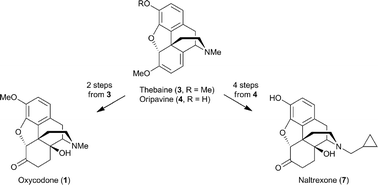Improved synthesis of 14-hydroxy opioid pharmaceuticals and intermediates†
Abstract
Significantly improved reaction conditions for the synthesis of

* Corresponding authors
a
Medicinal Chemistry, Monash Institute of Pharmaceutical Sciences, Monash University, 381 Royal Parade Parkville, Victoria, Australia
E-mail:
peter.scammells@monash.edu
Fax: (+61) 3 9903 9582
Tel: (+61) 3 9903 9542
Significantly improved reaction conditions for the synthesis of

 Please wait while we load your content...
Something went wrong. Try again?
Please wait while we load your content...
Something went wrong. Try again?
G. B. Kok and P. J. Scammells, RSC Adv., 2012, 2, 11318 DOI: 10.1039/C2RA21693K
To request permission to reproduce material from this article, please go to the Copyright Clearance Center request page.
If you are an author contributing to an RSC publication, you do not need to request permission provided correct acknowledgement is given.
If you are the author of this article, you do not need to request permission to reproduce figures and diagrams provided correct acknowledgement is given. If you want to reproduce the whole article in a third-party publication (excluding your thesis/dissertation for which permission is not required) please go to the Copyright Clearance Center request page.
Read more about how to correctly acknowledge RSC content.
 Fetching data from CrossRef.
Fetching data from CrossRef.
This may take some time to load.
Loading related content
